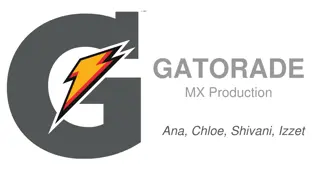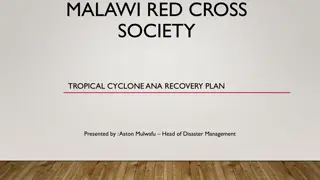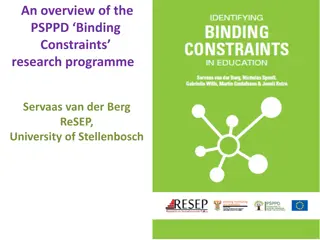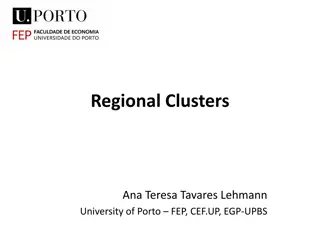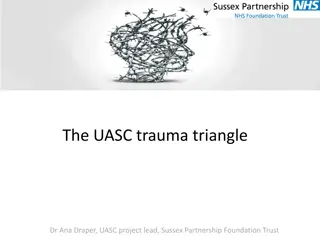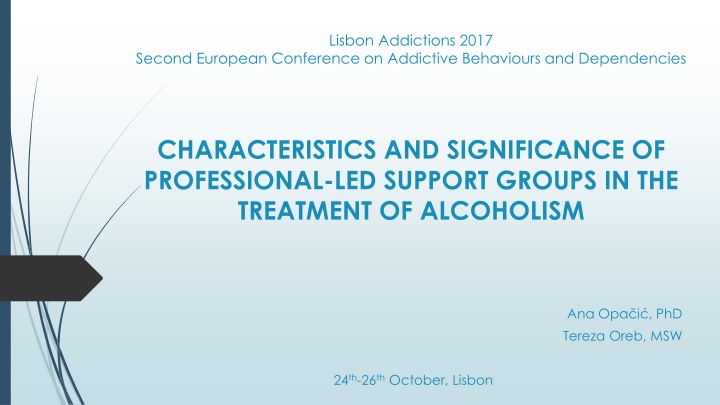
Professional-Led Support Groups in Alcoholism Treatment: Characteristics & Significance
Explore the characteristics and significance of professional-led support groups in treating alcoholism, focusing on Clubs of Treated Alcoholics in Croatia. Discover the therapeutic roles, research findings, and instruments used in enhancing recovery and social integration.
Download Presentation

Please find below an Image/Link to download the presentation.
The content on the website is provided AS IS for your information and personal use only. It may not be sold, licensed, or shared on other websites without obtaining consent from the author. If you encounter any issues during the download, it is possible that the publisher has removed the file from their server.
You are allowed to download the files provided on this website for personal or commercial use, subject to the condition that they are used lawfully. All files are the property of their respective owners.
The content on the website is provided AS IS for your information and personal use only. It may not be sold, licensed, or shared on other websites without obtaining consent from the author.
E N D
Presentation Transcript
Lisbon Addictions 2017 Second European Conference on Addictive Behaviours and Dependencies CHARACTERISTICS AND SIGNIFICANCE OF PROFESSIONAL-LED SUPPORT GROUPS IN THE TREATMENT OF ALCOHOLISM Ana Opa i , PhD Tereza Oreb, MSW 24th-26thOctober, Lisbon
1. Introduction (I) Clubs of Treated Alcoholics multifamily communities, principles: therapeutic community, self-help and mutual aid 180 CTA in Croatia Croatian Association of Clubs of Treated Alcoholics Inspired by AA, but: Absence of religious/spiritual component Professional leadership Encouraging for members to speak openly about themselves outside CTA Enhancing social integration via activities in community NGO with formal structure Participating on voluntary basis and court s decision Inclusion of family members Goal: maintaining abstinence, encouraging rehabilitation and social integration Free of charge, funded by local government, available at local level, on weekly basis, app. 12 families in the group, confidentiality, disulfiram (optional)
1. Introduction (II) Therapeutic role in CTA Mainly social workers, psychiatrists, nurses, psychologists, with further training Tasks: Speeding up the recovery process and positive behavioral changes Removing the resistance Providing stimulating atmosphere Respecting and appreciating client s personality Helping with organizing daily activities, making decisions and creating new sober relationships Personal change in wider sense Organizing out-group acitivities
Information about the reserach 40 randomly selected CTAs 465 person with alcholism problem and 200 person as a support member Research objectives: 1) To identify the contribution of member s functioning in the group and some dimensions of CTA on assessment of progress in various life aspects (e.g. marital and parental relations, self-concept, functioning at the work place). 2) To identify the contribution of member s functioning in the group and some dimensions of CTA on assessment of changes in psychosocial functioning (changes in cognitive reasoning, dealing with emotions and behavioral changes) Used hierarchical regression analysis
Research instruments Short questionnaire for assessing basic features of the member's functioning in CTA: e.g. gender, years of abstinence, experience of relapse, length of membership, usage of disulfiram, frequency of attending CTA, attending meetings with an accompanying person, participation in out-group activities, modality of entering CTA and frequency of various topics processed in the meeting. Questionnaire for assessment of progress in various life aspects (9 items, Cronbach = 0.924) Questionnaire for assessment of changes in psychosocial functioning with 14 items (Cronbach = 0.938.) Questionnaire for assessment of other members relation toward respondent with 9 items (Cronbach = 0.838). . Questionnaire for assessment of professional staff s relation towards member (12 items, 3 factor, Cronbach = 0,783) Scale for assessment of satisfaction with CTA (9 items, Cronbach = 0,8)
Perspectives from members with addiction problem: What aspects contribute to personal progress in various life aspects p ,542 ,142 ,404 ,408 ,814 ,026 -,064 -,036 ,035 ,010 4thstep in hierarchical regression analysis Gender Frequency of attending the meetings Participation in out-group activities Modes of becoming a member Frequency of attending meetings by an accompying person R2= ,475 F (change) = 16,210 p= 0.00 Other members relation towards respondent General atmosphere Variety of processed topics in the meetings Personal relation between an expert and a member Expert-member equality Mutual understanding between and expert and a member ,209 -,035 ,422 ,136 -,084 -,080 ,000 ,428 ,000 ,013 ,108 ,111 Satisfaction with the club as an organization ,198 ,000
Perspectives from members with addiction problem: What aspects contribute to changes in psychosocial functioning ,035 ,020 -,028 ,000 ,047 p ,400 ,636 ,510 ,992 ,260 4thstep in hierarchical regression analysis Gender Frequency of attending the meetings Participation in out-group activities Modes of becoming a member Frequency of attending meetings by an accompying person R2= ,510 F (change) = 7,693 p= 0.006 Other members relation towards respondent General atmosphere Variety of processed topics in the meetings Personal relation between an expert and a member Expert-member equality Mutual understanding between and expert and a member ,422 -,012 ,297 ,079 -,013 -,054 ,000 ,781 ,000 ,135 ,803 ,266 Satisfaction with the club as an organization ,131 ,006
Perspectives from supporting members: What aspects contribute to personal progress in various life aspects p 4thstep in hierarchical regression analysis Gender -,075 ,233 R2= ,553 Duration of membership in the CTA ,304 ,000 Relation with the member with addiction problem ,012 ,852 F (change)= 13,917 Frequency of attending the meetings ,016 ,811 Experience with relapse of a person with addiction ,093 ,110 p= 0.000 Participation in out-group activities ,078 ,224 Frequency of attending the meetings compared to person with addiction -,076 ,268 Sense of its position as an observer or as a member ,065 ,273 Expert s relation toward ,088 ,135 Variety of processed topics in the meetings ,274 ,000 Relation between an expert and a supporting members ,152 ,079 Satisfaction with expert s work ,070 ,350 Other members relation towards respondent ,258 ,002 Satisfaction with process aspects in the CTA ,111 ,106
Perspectives from supporting members: What aspects contribute to changes in psychosocial functioning -,035 ,158 ,056 -,072 ,000 ,088 -,018 ,040 ,088 ,123 ,022 ,052 ,606 ,060 p ,564 ,007 ,356 ,269 ,996 ,152 ,782 ,479 ,119 ,087 ,789 ,470 ,000 ,368 4thstep in hierarchical regression analysis Gender Duration of membership in the CTA Relation with the member with addiction problem Frequency of attending the meetings Experience with relapse of a person with addiction Participation in out-group activities Frequency of attending the meetings compared to person with addiction Sense of its position as an observer or as a member Expert s relation toward Variety of processed topics in the meetings Relation between an expert and a supporting members Satisfaction with expert s work Other members relation towards respondent Satisfaction with process aspects in the CTA R2= .595 F (change) = 16.124 p= 0.000
Conclusion Both members with addiction and their supporting members form sustainable family oriented groups treatments in alcoholism in Croatia Group surroundings has significant contribution to wider personal progress and psychsocial change Both treated alcoholics and their family members achieve best therapeutic results if quality of relations with other members and diversity of topics processed in club meetings are on a higher level.
Conclusion For people with addiction problem, a quality of personal relation with an expert and the status of the club as an organization in wider surrounding is additionally important predictor. For their family member, additionally important factor is duration of their membership in CTA with best results for those that participate longer. Results demonstrate that the best assessments are given by the members that are fully integrated not only in group work, but also in out-group activities and have strongest attachment to the club
References Brlek, I., Berc, G., & Mili Babi , M. (2014). Primjena savjetovanja kao metode pomo i u klubovima lije enih alkoholi ara iz perspektive socijalnih radnika. [Applying counseling methods to help the clubs AA from the perspective of social workers]. Socijalna psihijatrija, 42 (1), 62-70. Retrieved from: http://hrcak.srce .hr/127729 Car uljak, I., Culej, J., & Dodi , K. (2013). Oblici rehabilitacije lije enih alkoholi ara u zajednici - prikaz rada KLA. Hrvatski asopis za javno zdravstvo, 9 (33), 141-175. Retrieved from: https://hcjz.hr/index.php/hcjz/article/view/153/146 Hudolin, V. (1991). Alkoholo ki priru nik. Zagreb: Medicinska naklada. Miljenovi , A., & Radat, K. (2012). Klubovi lije enih alkoholi ara korak dalje. [Clubs for Treated Alcoholics a Step Forward]. Zagreb: Dru tvo za socijalnu podr ku. Opa i , A., Oreb, T., Radat, K. (2017.). Characteristics and Significance of Professional-Led Support Groups in the Treatment of Alcoholism. Alcoholism Treatment Quarterly, 35 (4), 359- 371. Torre, R. (2006). Oporavak alkoholi ara u klubovima lije enih alkoholi ara. Zagreb: Hrvatski savez lije enih alkoholi ara.
Thank you for your attention. ana.opacic@pravo.hr tereza.oreb@gmail.com


